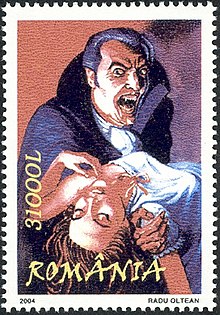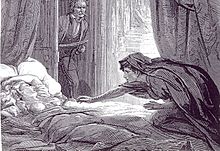|
Erotic horror Erotic horror, alternately called horror erotica or dark erotica, is a genre of fiction in which sensual or sexual imagery are blended with horrific overtones or story elements for the purpose of sexual arousal.[3] Horror fiction of this type is most common in literature, film and video games. Ero guroEro guro (エログロ), also known as just guro, is a Japanese genre of erotic art that focuses on a mix of eroticism with grotesque and horror elements. Originating from the ero guro nansensu subculture of the Shōwa era,[4] it first gained prominence in the popular literature of Japan in the 1920s and 1930s,[5] and regularly features violent scenes such as dismemberment, disembowelment, eyeball gore, and exploding wombs.[6] Following the Sada Abe Incident of 1936, in which a woman strangled and castrated her lover for sexual pleasure, ero guro media faced censorship.[5][7] Such erotica made a reemergence in the postwar period, especially in manga.[8] Later subgenres of hentai would be influenced by ero guro, including tentacle hentai.[9] In the 21st century, guro hentai has gained popularity in the United States.[6] Women's erotic horror Feminists have been hesitant to accept erotic horror, as both the erotic and horror have been primarily locations for the male gaze.[12] Pornography and the erotic, through a non-feminist gaze, are often about the coercion of women to performing sexual acts that they do not consent to.[12] Furthermore, erotic horror media written with rape, monstrous sex scenes, or the exchange of heterosexual power dynamics are not condoned by feminist scholars and activists; these forms of erotic horror are not deemed transgressive, empowering or feminist.[12] Contemporary women's horror, however, celebrates the erotic and encourages combining horror with eroticism in order to express what terrifies and titillates women without penalty, while still centering self-determination and sexual choice.[12] Writers and readers of feminist erotic horror works use them to express themselves as both a subject and object within a fantasy context.[12] Many feminist erotic horror pieces involve romantic relationships with a monster, such as vampires or werewolves, and/or the reworking of existing fairytales in order for female protagonists to take control of their own sexual fate.[12] These romantic relationships act as a lens for a transgression of these different monsters and a celebration of rich difference.[12] Although the vampire is traditionally understood as a masculine devourer of women,[13]: 158 modern erotic stories featuring women vampires are often transgressive in nature – women in these stories do not conform to expectations about marriage, sexual freedom, or heterosexual desire – and may be understood as altogether feminist.[14] Several of these stories feature the lesbian vampire, a trope in which vampirism and lesbian identity are connected.[14] In the 1970s, erotic vampire lesbian films (like Twins of Evil by John Hough, 1971) projected lesbian identity and vampirism as intertwined, and audiences viewed both as horrifying elements.[14] Erotic vampire lesbian horror is a diverse genre, and lesbian identities are constructed in several different ways: As members of a shared sisterhood, sexually violent, sadomasochistic, or supporting butch and femme distinctions.[14] More generally, although early works were limiting, modern lesbian erotic horror transgresses popular conceptions of what appropriate sexual desire can look like and celebrates difference.[14] Monster erotica Monster erotica, also known as monster porn,[15] is a genre of erotic art or pornography that features sexual encounters between humans and monsters. Typical monsters in the genre include dinosaurs[16] and zombies,[17] as well as folkloric or mythical creatures such as cryptids,[15] vampires, or werewolves.[12] Monster erotica is generally depicted as different than bestiality, as the monsters present are often intelligent and sapient; that being said, rape often takes place against humans in the genre.[15] Following media reports in 2013 that such books often contained scenes of rape, incest, and bestiality, various online retailers removed hundreds of self-published monster erotica books from their websites.[15] Monster erotica also appears in Japanese media, with examples such as tentacle hentai being popular.[9] Monster erotica sometimes features comedic or ironic themes, such as in the works of Chuck Tingle.[18] Vampires have been known to be icons of erotic horror since conception, especially Bram Stoker’s Dracula which includes overt female sexuality and voyeurism.[2] In different iterations of vampire stories, the vampire is constantly described as attractive and sexually alluring to humans.[19] Vampire bites and feeding are often described as pleasurable and sexual, as Violet Fenn notes in her analysis of vampire feeding within Dracula: “blood and lust are as one.”[19] Killing a vampire has also been analyzed as being sexually charged as it requires impalement or penetration by a stake to the heart.[2] Andrew Green notes in his analysis that the language used by Stoker for the death of the vampire Lucy Westenra is reminiscent of the language used to describe orgasms.[2] In film Erotic horror has had influences on Spanish,[20] French,[21] and American horror films. The works of Jean Rollin, such as Le Viol du Vampire and Fascination, are considered quintessential erotic horror films, blending deeply sexual imagery with gore.[21] American cinema has also featured notable erotic horror film franchises, such as Candyman.[22] An example of a British erotic horror film series is Hellraiser.[23] Alien features heavy erotic imagery, with the design of the Xenomorph by H. R. Giger featuring both phallic and vaginal imagery, intended to symbolize patriarchal guilt[24] as well as sex, rape, and pregnancy.[25] Body horror films, such as Crimes of the Future[26] and Titane,[27] have been likened to erotic horror.[28] See alsoReferences
Further reading
|